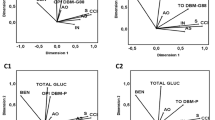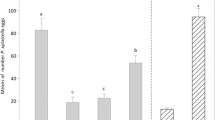Abstract
The diamondback moth (DBM), Plutella xylostella, is an oligophagous pest of cruciferous crops worldwide. Host plants of the DBM possess epicuticular wax, but thick wax is unfavorable to the selection of oviposition sites for female DBMs. How the DBM responds to host plant wax regarding oviposition site selection is largely unknown. The glucosinolates and wax levels in the cotyledons and true leaves of Chinese kale are different, which makes this plant an ideal host for exploring the oviposition behavior of the DBM. We found that although the true leaves contained more glucosinolates and waxy powder than cotyledons of healthy Chinese kale, DBM females preferred to lay eggs on the cotyledons over true leaves. However, the number of eggs laid on true leaves increased significantly when the waxy powder was artificially removed. Furthermore, the hatched larvae greatly preferred to feed and performed better on true leaves. In light of the current results, we propose that DBM females are hindered from laying eggs on the true leaves of Chinese kale by the outer layer of leaf wax powder. However, DBM females and larvae can adapt to the waxy host plant through adaptations: i.e., DBM females first lay eggs on the cotyledons where less wax exists, the hatched larvae then crawl to and spin silk nets on true leaves; the silk nets help subsequent DBM females overcome the obstacle of the wax and oviposit successfully on true leaves. These findings highlight new insights into plant–insect interactions.






Similar content being viewed by others
References
Ang GCK, Zalucki MP, Furlong MJ (2016) Temporal changes in olfactory and oviposition responses of the diamondback moth to herbivore induced host plants. Entomol Exp App 160:28–39
Badenes-Pérez FR, Gershenzon J, Heckel DG (2014) Insect attraction versus plant defense: young leaves high in glucosinolates stimulate oviposition by a specialist herbivore despite poor larval survival due to high saponin content. PLoS ONE 9:e95766
Badenes-Pérez FR, Gershenzon J, Heckel DG (2020) Plant glucosinolate content increases susceptibility to diamondback moth (Lepidoptera: Plutellidae) regardless of its diet. J Pest Sci 93:491–506
Badenes-Pérez FR, Reichelt M, Gershenzon J, Heckel DG (2013) Interaction of glucosinolate content of Arabidopsis thaliana mutant lines and feeding and oviposition by generalist and specialist lepidopterans. Phytochemistry 86:36–43
Badenes-Pérez FR, Reichelt M, Heckel DG (2010) Can sulfur fertilisation improve the effectiveness of trap crops for diamondback moth, Plutella xylostella (L.) (Lepidoptera: Plutellidae)? Pest Manag Sci 66:832–838
Brown PD, Tokuhisa JG, Reichelt M, Gershenzon J (2003) Variation of glucosinolate accumulation among different organs and developmental stages of Arabidopsis thaliana. Phytochemistry 62:471–481
Cao HH, Liu HR, Zhang ZF, Liu TX (2016) The green peach aphid Myzus persicae perform better on pre-infested Chinese cabbage Brassica pekinensis by enhancing host plant nutritional quality. Sci Rep 6:21954
Couty A, Van Emden H, Perry JN, Hardie J, Pickett JA, Wadhams LJ (2006) The roles of olfaction and vision in host-plant finding by the diamondback moth, Plutella xylostella. Physiol Entomol 31:134–145
Dias FM, Carneiro E, Casagrande MM, Mielke OH (2012) Biology and external morphology of immature stages of the butterfly, Diaethria candrena candrena. J Insect Sci 12:9
Dias FM, Casagrande MM, Mielke OH (2014) Biology and external morphology of the immature stages of the butterfly Callicore pygas eucale, with comments on the taxonomy of the genus Callicore (Nymphalidae: Biblidinae). J Insect Sci 14:91
Furlong MJ, Wright DJ, Dosdall LM (2013) Diamondback moth ecology and management: problems, progress, and prospects. Annu Rev Entomol 58:517–541
Gripenberg S, Mayhew PJ, Parnell M, Roslin T (2010) A meta-analysis of preference-performance relationships in phytophagous insects. Ecol Lett 13:383–393
Gupta PD, Thorsteinson AJ (1960) Food plant relationships of the diamond-back moth [Plutella maculipennis (Curt.)] II. Sensory regulation of oviposition of the adult female. Entomol Exp App 3:241–250
Harcourt DG (1957) Biology of the diamondback moth, Plutella maculipennis (Curt.) (Lepidoptera: Plutellidae), in Eastern Ontario. II. Life-history, behaviour, and host relationships. Can Entomol 89:554–564
Ibrahim MA, Nissinen A, Holopainen JK (2005) Response of Plutella xylostella and its parasitoid Cotesia plutellae to volatile compounds. J Chem Ecol 31:1969–1984
Justus KA, Dosdall LM, Mitchell B (2000) Oviposition by Plutella xylostella (Lepidoptera: Plutellidae) and effects of phylloplane waxiness. J Econ Entomol 93:1152–1159
Justus KA, Mitchell BK (1996) Oviposition site selection by the diamondback moth, Plutella xylostella (L.) (Lepidoptera: Plutellidae). J Insect Behav 9:887–898
Li ZY, Feng X, Liu SS, You MS, Furlong MJ (2016) Biology, ecology, and management of the diamondback moth in China. Annu Rev Entomol 61:277–296
Pivnick KA, Jarvis BJ, Gillot C, Slater GP, Underhill EW (1990) Daily patterns of reproductive activity and the influence of adult density and exposure to host plants on reproduction in the diamondback moth, Plutella xylostella (Lepidoptera: Plutellidae). Environ Entomol 19:587–593
Rahardjo BT, Tarno H (2018) Diamondback moth, Plutella xylostella (Linnaeus) responses on Chinese kale (Brassica oleracea Var. alboglabra) treated by plant growth promoting rhizobacteria. Asian J Crop Sci 10:73–79
Rahman M, Zalucki MP, Furlong MJ (2019) Diamondback moth egg susceptibility to rainfall: effects of host plant and oviposition behavior. Entomol Exp App 167:701–712
Rathcke BJ, Poole RW (1975) Coevolutionary race continues: butterfly larval adaptation to plant trichomes. Science 187:175–176
Reddy GVP, Tabone E, Smith MT (2004) Mediation of host selection and oviposition behavior in the diamondback moth Plutella xylostella and its predator Chrysoperla carnea by chemical cues from cole crops. Biol Control 29:270–277
Reed DW, Pivnick KA, Underhill EW (1989) Identification of chemical oviposition stimulants for the diamondback moth, Plutella xylostella, present in three species of Brassicaceae. Entomol Exp App 53:227–286
Renwick JAA, Haribal M, Gouinguené S, Stadler E (2006) Isothiocyanates stimulating oviposition by the diamondback moth, Plutella xylostella. J Chem Ecol 32:755–766
Renwick JAA, Radke CD (1990) Plant constituents mediating oviposition by the diamondback moth, Plutella xylostella (Lepidoptera: Plutellidae). Phytophaga 3:37–46
Rochfort SJ, Trenerry VC, Imsic M, Panozzo J, Jones R (2008) Class targeted metabolomics: ESI ion trap screening methods for glucosinolates based on MSn fragmentation. Phytochemistry 69:1671–1679
Roden DB (1993) Laddering: climbing behavior of the gypsy moth (Lepidoptera: Lymantriidae). Ann Entomol Soc Am 3:379–383
Sarosh BR, Wittstock U, Halkier BA, Ekbom B (2010) The influence of metabolically engineered glucosinolates profiles in Arabidopsis thaliana on Plutella xylostella preference and performance. Chemoecology 20:1–9
Shiojiri K, Takabayashi J, Yano S, Takafuji A (2002) Oviposition preferences of herbivores are affected by tritrophic interaction webs. Ecol Lett 5:186–192
Shiojiri K, Takabayashi J (2003) Effects of specialist parasitoids on oviposition preference of phytophagous insects: encounter-dilution effects in a tritrophic interaction. Ecol Entomol 28:573–578
Silva GA, Pereira RM, Rodrigues-Silva N, Souza TC, Ferreira DO, Silva GAR et al (2017) Wax removal and diamondback moth performance in collards cultivars. Neotrop Entomol 46:571–577
Silva R, Furlong MJ (2012) Diamondback moth oviposition: effects of host plant and herbivory. Entomol Exp Appl 143:218–230
Spencer JL, Pillai S, Bernays EA (1999) Synergism in the oviposition behavior of Plutella xylostella: sinigrin and wax compounds. J Insect Behav 12:483–500
Spencer JL (1996) Waxes enhance Plutella xylostella oviposition in response to sinigrin and cabbage homogenates. Entomol Exp Appl 81:165–173
Strong DR, Lawton JH, Southwood TR (1984) Insects on plants. Harvard Univ Press, Cambridge, MA
Talekar NS, Shelton AM (1993) Biology, ecology, and management of the diamondback moth. Annu Rev Entomol 38:275–301
Uefune M, Shiojiri K, Takabayashi J (2017) Oviposition of diamondback moth Plutella xylostella females is affected by herbivore-induced plant volatiles that attract the larval parasitoid cotesia vestalis. Arthropod-Plant Inte 11:235–239
Uematsu H (1996) Inter-leaf movement of larvae of diamondback moth, Plutella xylostella L. (Lepidoptera: Yponomeutidae) on rape (Brassica napus) seedlings. Jap J Appl Entomol Z 40:35–38
Acknowledgements
This work was supported by the Natural Science Foundation of China (31470484), the National Key R&D Program of China (No. 2017YFD0201000) and China Agriculture Research System (No. CARS-23-D-06).
Author information
Authors and Affiliations
Contributions
JY and SZ designed the research; JY and ZW performed research; LN and TX provided assistance; JY and SZ analyzed data; JY, SZ and TX wrote the manuscript. All authors read and approved the manuscript.
Corresponding author
Ethics declarations
Conflict of interest
The authors declare no conflicts of interest.
Additional information
Communicated by Antonio Biondi.
Publisher's Note
Springer Nature remains neutral with regard to jurisdictional claims in published maps and institutional affiliations.
Supplementary Information
Below is the link to the electronic supplementary material.
Supplementary file 1. Video S1. Fourth instar larvae of Plutella xylostella produce a “ladder” on the leaf by spinning to help them crawl. (MOV 3657 kb)
Supplementary file 2. Video S2. The “net” helps Plutella xylostella larvae stand for feeding. (MOV 2329 kb)
Supplementary file 3. Video S3. Fourth instar larvae of Plutella xylostella feed on a leaf. The feeding process was accompanied by spinning, and the thoracic legs clawed the fresh silk. (MOV 2090 kb)
Supplementary file 4. Video S4. The larvae of Plutella xylostella stand on the “net” to feed. (MOV 3407 kb)
Supplementary file 5. Video S5. The hydrophobicity of Chinese kale leaf before and after removing waxy powder. (MOV 8762 kb)
Rights and permissions
About this article
Cite this article
Zhu, JY., Xiang, ZW., Zhang, SZ. et al. Adaptations of Plutella xylostella adult females and larvae to waxy host plants. J Pest Sci 95, 203–214 (2022). https://doi.org/10.1007/s10340-021-01366-3
Received:
Revised:
Accepted:
Published:
Issue Date:
DOI: https://doi.org/10.1007/s10340-021-01366-3




